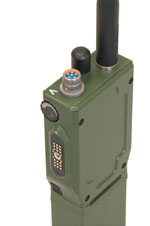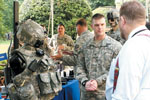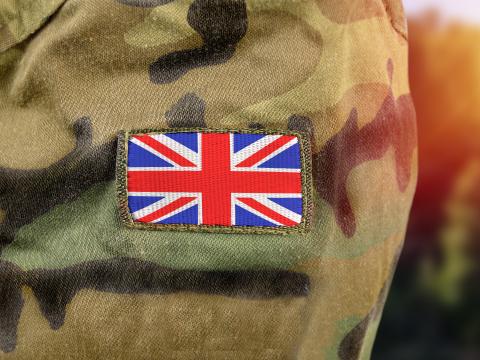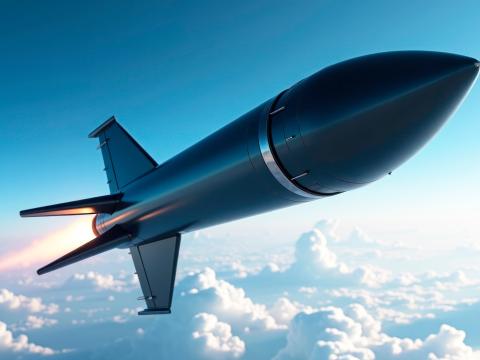Rifleman Moves Information Sharing to The Front of Operations
 |
| The Rifleman Radio is part of the Joint Tactical Radio System Handheld, Manpack, Soft Form Factor program and will bring communications to the tactical edge using an ad hoc network. |
The U.S. Army is pushing the network to the tactical edge in a viable way with the development of a new radio. The communications tool will enable individual soldiers to connect more efficiently among each other and with higher levels of leadership, employing a technology that allows troops to pass messages even without line of sight. Mass production of the core parts makes the radios affordable, and use of controlled but unclassified communications makes them applicable for uncleared personnel in infantry units.
The Small Form Factor (SFF)-C(V) 1 Rifleman Radio being developed by the Joint Program Executive Office Joint Tactical Radio System (JPEO JTRS), in conjunction with General Dynamics C4 Systems and Thales, is part of the Handheld, Manpack, SFF (HMS) program, which involves the development of a family of radios. The lower-end HMS form factors are worked into handheld and small-form-fit versions, and the manpack HMS radio is the first terminal to run the Mobile User Objective System satellite capability.
The Rifleman originally was scheduled to roll out as part of Land Warrior to fill that program’s need for a small variant of the SFF-C for use by soldiers at the lowest level. The SFF-C has been integrated with Land Warrior and has been tested but not fielded, in part because the waveform is not through development. The Rifleman now will be distributed on its own and as part of the Ground Soldier Ensemble. To operate the radio in a stand-alone fashion, troops attach a battery and antenna, and then they can use it as a mounted or handheld tool. The radio is software-defined so it can be upgraded easily. It is interoperable and employs the Soldier Radio Waveform (SRW), the first networking waveform to reach the tactical edge of the battlefield.
Unlike most other radios in JTRS, which are National Security Agency (NSA) Type 1 certified, the Rifleman will be an NSA Type 2 radio. It will offer controlled but unclassified communications, so soldiers can employ it without requiring security clearances. This solves one radio problem for infantry units, which comprise mostly troops who are not cleared. The NSA Type 2 encryption bars classified information from being passed during transmissions and makes secure information more difficult for enemies to intercept.
In addition to its lower security classification, the Rifleman is different from other defense radios in several ways. Most of the other formats are designed for higher power output, use a more power-intensive waveform, and can be mounted in aircraft and vehicles. The Rifleman is designed to support a team over a range of a few miles rather than the large distances covered by its counterparts. The radio has a built-in commercial rather than a military Global Positioning System (GPS) unit that can report a soldier’s location to higher levels such as a squad leader.
Those factors, combined with the fact that other JTRS radios are purchased in lower volumes, contribute to make the Rifleman less expensive than other radios. “It’s aimed at a different mission,” explains Chris Brady, vice president of assured communications systems at General Dynamics C4 Systems. HMS radios are built with modular pieces, one of which is the core radio and the innards of the Rifleman. The more core radios that are sold, the lower the price becomes. Other systems, such as the unattended ground system, use the same core radio as well.
Another benefit the Rifleman offers to the military is the ability to enable troops to talk to anyone on the network, as long as they can connect to any other radio. It does not require line of sight to operate but can hop through various radios on the network. This ad hoc networking allows team members to stay in contact when they lack a direct link to one another by routing through an intermediate teammate. Even in a cave, a soldier could connect back into the network by linking through other radios.
“It’s a large leap in capability,” explains Col. Daniel P. Hughes,
The Rifleman will offer for the first time communications down to the tactical edge. “[The Army] is trying to get the network down to the soldier,” the colonel states. “This is how it gets there.” The communications the military will have in place with the distribution of the Rifleman will connect to the ultimate network for the U.S. Defense Department. Larger infrastructure work for that network is being conducted at military posts, camps and stations. Col. Hughes explains that the Army leadership, such as the chief of staff and the secretary of the Army, is focused on how to provide the network to the boots on the ground, and he emphasizes that the mission is being accomplished. “My bottom line is we’re getting the network to the soldier,” he states. “We’re doing it.”
General Dynamics built the engineering development model for the Rifleman and is scheduled to deliver 40 units to the Army Evaluation Task Force at
 |
| At the Program Executive Office Soldier display held in the Pentagon courtyard in June, Staff Sgt. James Young, USA, demonstrates the Land Warrior System attached to his body armor and helmet. The Rifleman Radio originally was part of the Land Warrior System, but will be rolled out as a stand-alone device and as part of the Ground Soldier Ensemble. |
After the product is ready for full rollout, Col. Hughes says any of the light infantry units could be the first to receive the Rifleman. When soldiers have the radios in hand, they should be able to operate them with minimal instruction; they are “as user-intuitive as possible,” the colonel explains. The initial application for the radio is for the riflemen on infantry teams, but eventually use of the radio could spread to additional personnel. Though developers are aiming and building the Rifleman for soldiers, the U.S. Marine Corps also has expressed strong interest in the technology for its troops.
Once warfighters employ the radios, leadership can monitor their positions more closely through the commercial GPS included in the systems. The Rifleman does not have a display, so it can only transmit location, not give that information to users. If one or more of the units is spooked, personnel can turn off that capability and discontinue use of that site to move forward. Instead, the locating function will transfer over to a team member using a radio with fully compliant military GPS, and service members will employ that capability for further mission requirements.
Col. Hughes says the military would like to use the military GPS in most places because of its capabilities, such as better encryption and lack of susceptibility to enemy attack. However, commercial GPS is much less expensive, and positioning capability is not the Rifleman’s most important role. “We really want these radios very specifically for voice communications,” he says. The use of commercial versus military GPS is a trade-off of cost, maintenance and performance, all of which are lower for the commercial version.
Though the JTRS program primarily is interested in the radios’ voice capabilities, the Rifleman can perform other tasks such as passing data and even video by connecting to a data terminal. The colonel believes that the Rifleman will enhance the capabilities of individual soldiers and the larger Army. It will give the service a networking capability it has never had before and should enhance the ability to maneuver and carry out operations. In addition, a new concept of operations will develop as the radio goes through its various test stages.
Operational personnel in the Army also will have to consider new concepts as they examine how the Rifleman will affect operations. With the better maneuvering and coordination capabilities, soldiers will conduct missions differently. While they still will follow doctrine, they should be able to complete certain tasks—such as entering and clearing a building—faster and more safely. Individual locations will be known, and the ability to transfer data will be enhanced.
The Rifleman’s advancing development comes after years of work on its various parts and pieces, including its waveform. The SRW has been in the pipeline for nearly a decade, beginning with efforts at the Defense Advanced Research Projects Agency and the Army’s Communications-Electronics Research, Development and
The availability of bandwidth to the network edge and the ability to move significant amounts of information to and from the edge are major concerns for the military. The most pressing requirement is the ability to pass voice communications, followed by a need for situational awareness information and position location. In the future, moving video over the network also will become critical. The Rifleman can offer those capabilities to warfighters and, according to Brady, is positioned to deliver unprecedented power to the network edge.
The Rifleman will deliver 10 to 100 times the bandwidth to the tactical edge and make sharing more secure. Many of the radios being used in forward operations now are not given to individual soldiers, who instead use hand signals to pass information. The radios will be a step up technically and security-wise from manual communications.
The maintenance plan for the Rifleman is still subject to a business case. However, because the devices are so inexpensive and include few parts—essentially a headset, battery, antenna and radio—if elements do break, they will be considered disposable. General Dynamics has warranty requirements, but maintenance is fairly limited. If a soldier breaks a piece, the company will replace it.
Web Resources
General Dynamics C4 Systems Rifleman Radio: www.gdc4s.com/documents/D-JTRSRFL-1-0908.pdf
Joint Program Executive Office Joint Tactical Radio System: http://jpeojtrs.mil/
General Dynamics/Mobile User Objective System: www.gdc4s.com/content/detail.cfm?item=2c63816d-67d1-4de2-a33f-59a2285aa0cd



Comments